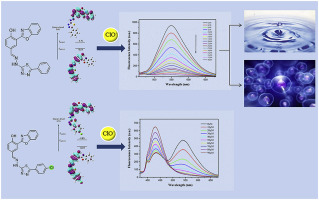Dyes and Pigments ( IF 4.5 ) Pub Date : 2018-09-28 , DOI: 10.1016/j.dyepig.2018.09.071 Li-Dong Chen , Hong-Lin Ding , Ning Wang , Yue An , Cheng-Wei Lü

|
In this paper, two simple probes (L1 and L2) have been designed and synthesized for detection of ClO− with large Stokes shifts (about 200 nm). Both probes can react with ClO− in less than one min and display obvious changes in fluorescence, which showing potential ability of detection ClO− in real time. ES-MS analysis was utilized to confirm our design strategy and the possible detection mechanism. Owing to the delicate difference of structure of two probes, L2 has a significant fluorescence ratio response to ClO− and the fluorescence of L1 is quenched. L1 has a longer emission wavelength, better response characteristics and weaker cytotoxicity (IC50 28.1 μM) as compared with L2. The detection limit of L1 is even as low as 0.09 μM. What's more, it is successfully used in monitoring ClO− real water samples and in living cells.
中文翻译:

两种高度选择性和灵敏的荧光探针设计并应用于次氯酸盐的特异性检测
在本文中,两个简单的探针(L1和L2)被设计和用于检测CLO的合成-用大的斯托克斯频移(约200纳米)。两种探针可以与CLO反应-在少于一分钟,并显示在荧光明显的变化,这表示检测CLO的潜在能力-实时。ES-MS分析被用来确认我们的设计策略和可能的检测机制。由于两个探针的结构的微妙差异,L2具有显著荧光比例响应至C10 -和的荧光L1被淬灭。L1与L2相比,具有更长的发射波长,更好的响应特性和更弱的细胞毒性(IC 50 28.1μM)。L1的检测极限甚至低至0.09μM。更重要的是,它成功地监测CLO使用-实际水样,并在活细胞中。



























 京公网安备 11010802027423号
京公网安备 11010802027423号